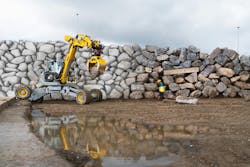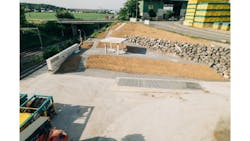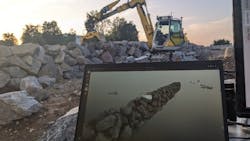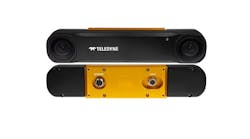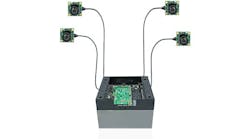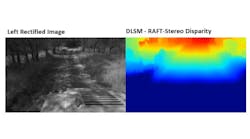A park in Switzerland includes some unusual elements: a stone retaining wall and terraced landscape built by an autonomous excavator.
The robotic excavator used in the project is the HEAP (Hydraulic Excavator for an Autonomous Purpose), a customized Menzi Muck (Ruthi, Switzerland) M545 12t walking excavator. HEAP was developed by the Robotic Systems Lab, Eidgenössische Technische Hochschule Zürich, or ETH Zurich (Zurich, Switzerland), a polytechnic university. The team worked with the chair of the landscape architecture department at ETH Zurich.
“As the building industry is a major contributor to global greenhouse emissions, it is critical to leverage new technologies toward more sustainable building practices. One such avenue is to rethink and reshape the embodied energy of material systems that are used in construction. In particular, developments in on-site robotic building methods offer the opportunity to leverage context-specific, locally sourced or upcycled materials that are inexpensive, abundant, and low in embodied energy,” the researchers from ETH Zurich explain.
For example, autonomous construction systems can use boulders found on-site as well as concrete remnants from other projects to build retaining walls.
As an initial demonstration project, the researchers from ETH Zurich built a 10 x 1.7 x 4 m-long freestanding stone wall out of 109 boulders and concrete pieces. The structure was built over a two-week period at a rate of 17.4 minutes per stone, which is nearly as fast as would be possible with human operators.
Using the hands-on experience gained building the first wall, the researchers then built a permanent retaining wall with dimensions of 65.5 x 1.8 x 4 m out of 938 elements, which they integrated into a four-level terraced landscape with two pedestrian access ramps at Circularity Park in Oberglatt, Switzerland. The wall-and-terrace structure allows people to traverse differences in the park’s natural elevation. The structure also helps control water runoff and soil erosion.
Related: Drones, High Resolution Cameras Boost Inspection Safety and Quality
Because the freestanding wall was built on a concrete slab inside a facility, it was constructed without a human inside the cab of the excavator.
On the other hand, the permanent retaining wall was built on-site in the park, so a person, sitting in the cabin, managed unexpected situations such as a falling stone or one that didn’t settle into place as expected. And, while the excavator picked, placed, and scanned stones autonomously, the human drove the excavator.
Autonomous Process to Build the Wall
Reporting on their work in Science Robotics (bit.ly/3Jv0Hhb) the researchers write, “Our comprehensive pipeline allows for the construction of arbitrarily curved and explicitly defined wall shapes from highly heterogeneous stones, using light detection and ranging (LiDAR) mapping, learned image segmentation, grasp heuristics, and classification to isolate, digitize, and manipulate stone instances in unstructured environments.”
The wall-building process began by creating a point-cloud representation of available boulders and concrete pieces. To accomplish this, the excavator picked up individual stones in its gripper, scanned them using LiDAR sensors mounted on its cabin and boom, and then returned them to the ground.
This allowed the researchers to develop a limited inventory of stones represented by the point cloud, which geometric planning software used to develop an initial plan for the wall.
The excavator then picked up each stone again to place it in the wall, reorienting it as necessary. After HEAP placed the stone, the vision system scanned the stone again and then updated the geometric planning software.
These steps happened dynamically as the excavator completed its work.
In a separate but related project, HEAP also worked on terraced landscaping. Specifically, the autonomous excavator dug up the soil at the site and dumped it nearby, so the soil could be reused to form the terraces.
Components of the Machine Vision System
The AI-enabled machine-vision building system was comprised of numerous components.
Specifically, a Velodyne (San Jose, CA, USA) Puck VLP-16 LiDAR scanner and a Livox (Shenzhen, China) MID-70 LiDAR sensor were mounted at the front edge of the cabin’s roof. A second Livox Mid-70, mounted on the excavator’s arm, provided an overhead view. A RGB Blackfly from Teledyne FLIR (Wilsonville, OR, USA) was mounted at the base of the cabin and a second RGB camera was mounted on the roof.
A machine controller solution—iCON iXE3 3D from Leica Geosystems (St. Gallen, Switzerland)—automated the functioning of the boom and bucket on the excavator. It created a 3D map during the swing motion of the boom. As the boom swung to the side, the map was updated with information from the LiDAR sensors.
Draw wire encoders were used to measure the position and velocity of the hydraulic arm and grapple cylinders.
Related: Dragonflies: A Blueprint for Drones
All software is written in C++, and the robot operating system (ROS) is used to transfer data over the network between the different software nodes, which were distributed on several computers. The ROS master, managing the connection between processes, is located on the on-board computer of HEAP.
“The process provides a fully reversible alternative to concrete that can be applied, for example, to the construction of retaining walls, load-bearing structures, and revetments for civil infrastructure and landscaping,” the researchers conclude on a website created for the project.
